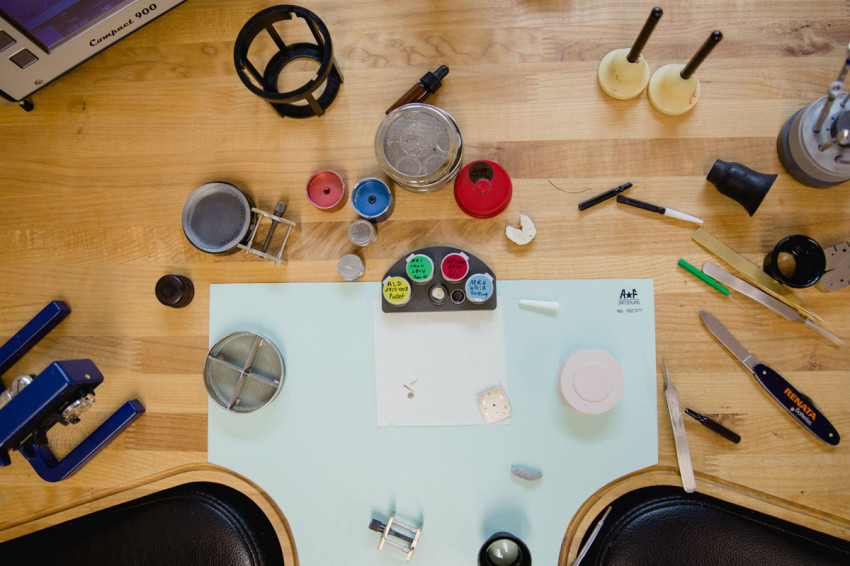Timeless Appeal at Portland’s Swiss Time
The Guyot family's passion for watchmaking has been passed down through the generations.

Originally published May 2016
Stephany Guyot was still playing under the stairs at her parents’ watch store when she started fixing timepieces.
“Mom and Dad would set up a little bench, and my brother and I would sit in there and pretend we were watchmakers,” she says. “They always had these boxes of junk watches, and my brother and I would be like, ‘Let’s try to get something to work.’ I guess I’ve always had a fascination with them.”
The fascination runs in the family.
Stephany’s father, Claude, grew up just outside of Fleurier, a small village in Switzerland known for its watchmaking and absinthe. Claude says people in the village either became farmers or watchmakers, so at age 16, he started watchmaking school. He spent the next eight years working on watches in Switzerland until he answered a newspaper ad for a job at the Waltham Watch Company in Bridgeport, Connecticut. He arrived in New York in 1972 with a duffle bag, a guitar, and a fluency in English comprised of the words “shut up” and a four-letter expletive.



At Waltham, Claude trained workers in the repair department. Even at that time, it was difficult to find watchmakers in America, so it wasn’t unusual for Swiss watchmakers to be recruited from overseas, says Jill, Claude’s wife. Claude planned to stay in America for two years. Instead, he met Jill, who was working at Waltham in the customer service department and also had roots in the watch industry. Her first job was at her father’s watch store in Westport, Connecticut; her grandfather was a jeweler and watchmaker with a store in neighboring Norwalk. Above the door of Swiss Time hangs a sign in the shape of a three- foot-tall pocket watch, passed down from Jill’s grandfather to her father to her.
After a few years, Jill and Claude left Waltham and moved to Maine. In 1977, the couple opened Swiss Time as a trade shop, doing repairs for local jewelry stores. It was located on the third floor of a High Street building, across from what is now the Westin Portland Harborview hotel. After the couple had operated the trade shop for two years, the building owner asked them if they were interested in moving down to a storefront on the first floor.
“We decided, why not?” Jill recalls. “I know retail; I grew up in it. He knows watches. So that’s when we moved down, and it worked. We’ve just grown from then.”
They moved the business to its present location on Exchange Street in 1994, and the customers followed. Some of them have been bringing their watches to Claude for over three decades. One customer, Paul Pappas, says he’s purchased seven or eight watches from Swiss Time over the last 25 years. Whenever he goes to buy a watch or watch strap or get a timepiece serviced, even if it’s been a year between visits, he is greeted by name. “It’s the Cheers of watch stores,” he says. Pappas, who lives in Yarmouth and owned a tire business and car wash before retiring, understands the value of supporting local businesses, and says the way Swiss Time treats its customers makes it easy to reciprocate the loyalty. “If I don’t buy my watches from them and they go out of business, then they won’t be there to be able to repair them,” Pappas says.
Although the watches Swiss Time repairs can be more than a century old, the equipment required to test them is state-of-the-art. To be certified to work on specific brands, including Rolex, Omega, and Longines, the store must continuously update its equipment and be ready for unannounced white-glove inspections from the manufacturers. Stephany says it’s crucial to keep the work environment clean because “a little speck of dust can float right to a watch you’re working on, and it will just stop the whole thing. It will never run right.”
The store continues to evolve. With the growth of online shopping, the majority of the store’s revenue has shifted from retail sales to repair work, says Stephany, who has been taking over more and more store operations from her parents since 2010. Claude, in his 60s, is still working on the watches, but his daughter is now apprenticing under him, starting out with a couple of pocket watches a week. She will eventually move on to mechanical wristwatches with smaller movements.
A movement is the interior mechanism in a watch. Until the introduction of a battery- powered quartz watch in 1969, all watches had mechanical movements, which don’t require batteries to work and instead rely on manual winding of the watch or, in an automatic watch, the motion of the wearer’s arm. The movement is powered by the mainspring, a coiled piece of metal that, in unwinding, transmits power to the balance wheel, which then rotates to power a series of tiny gears. These in turn move the watch’s hands. Today, mechanical movements are mostly found in high-end timepieces or vintage watches, and require occasional cleaning and servicing. Swiss-made mechanical movements, designed by watchmakers to be repaired, are mostly found in mid- to high-end or vintage timepieces. All mechanical watches need routine maintenance.
To service or repair a mechanical watch, Claude will take apart the entire movement, screw by screw, gear by gear—often over 100 pieces. Claude doesn’t make watches, but he can make the tiny parts, if needed, using a lathe. He does this less than he used to, as it’s an extremely delicate and time-intensive process; some of the parts are smaller than the tip of a pin. “There are very few people who make parts,” says Jill. “It’s a dying trade. It really is.” Still, Claude keeps his lathes in the back of his shop for special cases.



Quartz movements, which are battery powered, revolutionized the watch industry. They’re more accurate than mechanical movements and don’t have nearly as many moving parts, making them more shock- resistant. They can be produced much more cheaply and quickly. But even though there are high-end quartz watches, they don’t require the meticulous craftsmanship necessary to make mechanical watches— miniature kinetic engines built by hand. A mechanical watch, with proper care, will outlive its wearer.
“I like to say a mechanical watch has a heartbeat,” says Stephany. “You can almost always repair it. With a battery-operated watch, you get something that’s more disposable.”
The drive for longevity is reflected in Swiss Time’s retail offerings. While the store carries a dozen lines of new watches like Oris, Ball, Hamilton, and Tissot, its U-shaped display case also features reconditioned timepieces dating back to the turn of the twentieth century, including Hamilton, Omega, Rolex, and Patek Philippe wristwatches, as well as Waltham and Illinois pocket watches.
Recently, a younger audience has discovered the appeal of traditional watches. Swiss Time’s regular customers tend to be older, but Stephany says the last couple of years have seen an uptick in younger visitors to the store. More customers in their 20s or 30s, and even some teenagers, are interested in mechanical watches, both vintage pieces and new automatics, she says. Some find their grandparents’ old watches; others want to look more refined at work.
“It’s always been a way to set you apart, with the variety of watches,” says Stephany. “It becomes part of you, not only to tell the time but to make a statement about who you are.”
It’s a notion Swiss Time has embraced for nearly 40 years—when Jill and Claude ran a third-floor repair shop, when Stephany used to play under the staircase as a child, and now, when Stephany is learning the craft, hunched over a workbench with a magnifying glass in her eye.

